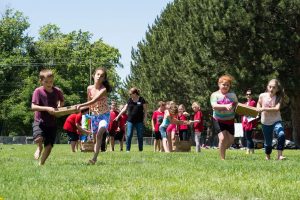19
Children grow and develop at a rapid pace. The development of both gross and fine motor skills helps a child to develop and allow them to participate in more activities. Motor development occurs in an orderly sequence as infants move from reflexive reactions (e.g., sucking and rooting) to more advanced motor functioning. As motor skills develop, there are certain developmental milestones that young children should achieve. For each milestone there is an average age, as well as a range of ages in which the milestone should be reached.
Fine motor skills focus on the muscles in our fingers, toes, and eyes, and enable coordination of small actions (e.g., grasping a toy, writing with a pencil, and using a spoon). In middle childhood, fine motor skills are also being refined in activities such as pouring water into a container, drawing, coloring, and using scissors. Some children’s songs promote fine motor skills as well (have you ever heard of the song “itsy, bitsy, spider”?). Mastering the fine art of cutting one’s own fingernails or tying shoes will take a lot of practice and maturation.
Motor skills continue to develop during middle childhood, especially as children enter the school system and gain more opportunities to practice writing. For example, by the age of six, most children can write the alphabet, their name, and the numbers 1 through 10. However, it is not uncommon for them to use their whole arm while writing, which often results in large and uneven letters. As their fine motor skills continue to improve, their handwriting becomes more controlled and legible.

Gross motor skills focus on large muscle groups that control our head, torso, arms and legs and involve larger movements (e.g., balancing, running, and jumping). These skills begin to develop first. Examples include moving to bring the chin up when lying on the stomach, moving the chest up, and rocking back and forth on hands and knees. As children enter primary school, they have more opportunities to participate in organized sports, which contributes to the development of their gross motor skills. In general, gross motor skills improve in four major areas during middle childhood: flexibility, balance, agility, and force.

Exercise and Sports
Middle childhood seems to be a great time to introduce children to organized sports, and in fact, many parents do. Nearly 3 million children play soccer in the United States (United States Youth Soccer, 2012). This activity promises to help children build social skills, improve athletically, and learn a sense of competition. However, it has been suggested that the emphasis on competition and athletic abilities can be counterproductive and lead children to grow tired of the game and want to quit. In many respects, it appears that children’s activities are no longer children’s activities once adults become involved and approach the games as adults rather than children. The U. S. Soccer Federation recently advised coaches to reduce the amount of drilling engaged in during practice and to allow children to play more freely and to choose their own positions. The hope is that this will build on their love of the game and foster their natural talents.
Sports are important for children. Children’s participation in sports has been linked to:
- Higher levels of satisfaction with family and overall quality of life in children
- Improved physical and emotional development
- Better academic performance
CDC ( U.S. Department of Health and Human Services, 2018) recommends that children and adolescents between the age of 6 to 17 years old to have 60 minutes or more of moderate-to-vigorous intensity physical activity each day, including:
- Aerobic activity: Most of the daily 60 minutes or more should include activities such as walking, running, or anything that makes their hearts beat faster. At least 3 days a week should include vigorous-intensity activities.
- Muscle-strengthening: Includes activities like climbing or doing push-ups, at least 3 days a week.
- Bone-strengthening: Includes activities such as jumping or running, at least 3 days a week.
Yet, a study on children’s sports in the United States (Sabo & Veliz, 2008) has found that gender, poverty, location, ethnicity, and disability can limit opportunities to engage in sports. Girls were more likely to have never participated in any type of sport (see Figure 3.2.1). They also found that fathers may not be providing their daughters as much support as they do their sons.
While boys rated their fathers as their biggest mentor who taught them the most about sports, girls rated coaches, and physical education teachers as their key mentors. Sabo and Veliz also found that children in suburban neighborhoods had much higher participation in sports than boys and girls living in rural or urban centers. In addition, Caucasian girls and boys participated in organized sports at higher rates than minority children (see Figure 3.2.2).

Figure 3.2.1.Participation in organized sports (%) by gender.

Figure 3.2.2. Participation in organized sports (%) by race and ethnicity.
Finally, Sabo and Veliz asked children who had dropped out of organized sports why they left. For both girls and boys, the number one answer was that it was no longer any fun (see Table 4.4.1). According to the Sports Policy and Research Collaborative (SPARC) (2013), almost 1 in 3 children drop out of organized sports, and while there are many factors involved in the decisions to drop out, one suggestion has been the lack of training that coaches of children’s sports receive may be contributing to this attrition (Barnett, Smoll & Smith, 1992). Several studies have found that when coaches receive proper training, the drop-out rate is about 5% instead of the usual 30% (Fraser-Thomas, Côté, & Deakin, 2005; SPARC, 2013).
Table 3.2.1. Top reasons dropped out or stopped playing organized sports by gender

Welcome to the World of E-Sports
The recent SPARC (2016) report on the “State of Play” in the United States highlights a disturbing trend. One in four children between the ages of 5 and 16 rate playing computer games with their friends as a form of exercise. In addition, e-sports, which as SPARC writes, is about as much a sport as poker, involves children watching other children play video games. over half of males, and about 20% of females, aged 12-19, say they are fans of e-sports.
Since 2008 there has also been a downward trend in the number of sports children are engaged in, despite a body of research evidence that suggests that specializing in only one activity can increase the chances of injury while playing multiple sports is protective (SPARC, 2016). A University of Wisconsin study found that 49% of athletes who specialized in a sport experienced an injury compared with 23% of those who played multiple sports (McGuine, 2016).
Physical Education
For many children, physical education in school is a key component in introducing children to sports. After years of schools cutting back on physical education programs, there has been a turnaround, prompted by concerns over childhood obesity and related health issues. Despite these changes, currently, only the state of Oregon and the District of Columbia meet PE guidelines of a minimum of 150 minutes per week of physical activity in elementary school and 225 minutes in middle school (SPARC, 2016).
Media Attributions
- 6yo handwriting
- primary school exercise

